Solving Equations
- 格式:ppt
- 大小:461.50 KB
- 文档页数:15
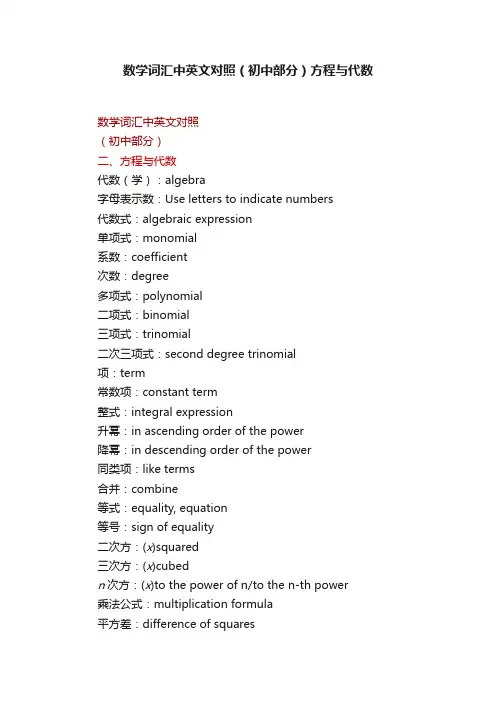
数学词汇中英文对照(初中部分)方程与代数数学词汇中英文对照(初中部分)二、方程与代数代数(学):algebra字母表示数:Use letters to indicate numbers代数式:algebraic expression单项式:monomial系数:coefficient次数:degree多项式:polynomial二项式:binomial三项式:trinomial二次三项式:second degree trinomial项:term常数项:constant term整式:integral expression升幂:in ascending order of the power降幂:in descending order of the power同类项:like terms合并:combine等式:equality, equation等号:sign of equality二次方:(x)squared三次方:(x)cubedn次方:(x)to the power of n/to the n-th power乘法公式:multiplication formula平方差:difference of squares平方差公式:formula for the difference of squares 完全平方:perfect square完全平方公式:formula for the perfect square分解因式:factorizing公因式:common factor提公因式法:method of extracting common factors 十字相乘法:method of cross multiplication分组分解法:method of regrouping长除法:long division分离系数法:method of detached coefficients分式:algebraic fraction无意义:illegal有意义:legal有理式:rational expression约分:reduction of a fraction最简分式:simplest fraction通分:turn fractions to a common denominator最简公分母:simplest common denominator根式:radical根指数:radical exponent被开方数:radicand二次根式:quadratic surd最简二次根式:simplest quadratic surd同类二次根式:similar quadratic surds分母有理化:rationalize a denominator有理化因式:rationalizing factor根:root增根:extraneous root已知数:given number未知数:unknown number方程:equation列方程:form an equation等量关系:equality检验:check根:root解方程:solving equation解法、解:solution一元一次方程:linear equation in one variable方程的解:solution of equation移项:transposition of terms去括号:remove brackes去分母:remove denominator化简:simplify不成立:false不等式:inequality一元一次不等式:linear inequality in one unknown一元一次不等式组:system of linear inequalities in one variable不等号:non-equal sign含绝对值的不等式:inequality with absolute value大于:greater than小于:less than大于等于:greater than or equal to小于等于:less than or equal to不等式性质:property of inequality解集:solution set解不等式:solve inequality公共部分:common part无解:no solution二元一次方程:linear equation in two unknowns二元一次方程组:system of linear equations in two unknowns 代入(消元)法:elimination by substitution加减(消元)法:elimination by addition and subtraction三元一次方程:linear equation in three unknowns三元一次方程组:system of linear equations in three unknowns一元二次方程:quadratic equation in one unknown一般式:general form二次项:quadratic term一次项:linear term常数项:constant term开平方法:radication因式分解法:factorization配方法:complete a perfect squae求根公式法: formula method一元二次方程根的判别式:discriminant of quadratic equation in one variable整式方程:integral equation一元整式方程:linear integral eqution一元高次方程:linear high-order equation二项方程:binomial equation双二次方程:biquadratic equation分式方程:fractional equation无理方程:irrational equation二元二次方程:quadratic equation in two variables一元二次不等式:quadratic inequality in one variable。
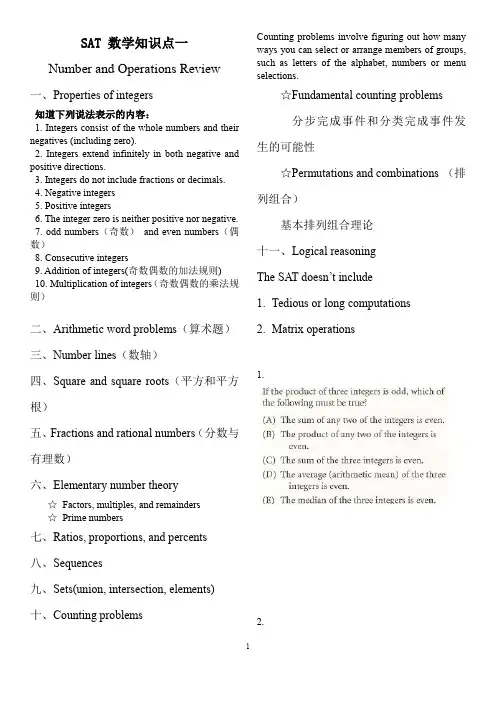
SAT 数学知识点一Number and Operations Review 一、Properties of integers知道下列说法表示的内容:1. Integers consist of the whole numbers and their negatives (including zero).2. Integers extend infinitely in both negative and positive directions.3. Integers do not include fractions or decimals.4. Negative integers5. Positive integers6. The integer zero is neither positive nor negative.7. odd numbers(奇数)and even numbers(偶数)8. Consecutive integers9. Addition of integers(奇数偶数的加法规则)10. Multiplication of integers(奇数偶数的乘法规则)二、Arithmetic word problems(算术题)三、Number lines(数轴)四、Square and square roots(平方和平方根)五、Fractions and rational numbers(分数与有理数)六、Elementary number theory☆Factors, multiples, and remainders☆Prime numbers七、Ratios, proportions, and percents八、Sequences九、Sets(union, intersection, elements)十、Counting problems Counting problems involve figuring out how many ways you can select or arrange members of groups, such as letters of the alphabet, numbers or menu selections.☆Fundamental counting problems分步完成事件和分类完成事件发生的可能性☆Permutations and combinations (排列组合)基本排列组合理论十一、Logical reasoningThe SAT doesn’t include1.Tedious or long computations2.Matrix operations1.2.3.4.5. 6.7.8.9.10.11.12.13. 14.SAT数学知识点二Algebra and Functions Review Many math questions require knowledge of algebra. This chapter gives you some further practice. You have to manipulate and solve a simple equation for an unknown, simplify and evaluate algebraic expressions, and use algebraic expressions, and use algebraic concepts in problem-solving situations.For the math questions covering algebra and functions content, you should be familiar with all of the following basic skills and topics:一、Operations on algebraic expressions二、Factoring三、Exponents四、Evaluating expressions with exponents and roots五、Solving equations☆Working with “unsolvable” equations☆Solving for one variable in terms of another☆Solving equations involving radical expressions六、Absolute value 七、Direct translation into mathematical expressions八、Inequalities九、Systems of linear equations and inequalities十、Solving quadratic equations by factoring 十一、Rational equations and inequalities 十二、Direct and inverse variation十三、Word problems十四、Functions☆Function notation and evaluation☆Domain and range☆Using new definitions☆Functions as models☆Linear functions: their equations and graphs☆Quadratic functions: their equations and graphs☆Qualitative behavior of graphs and functions☆Translations and their effects on graphsand functionsThe SAT doesn’t include:一、Solving quadratic equations thatrequire the use of the quadraticformula二、Complex numbers三、Logarithms1.2.3.4. 5.6.7.8.9.10.SAT 数学知识点三Geometry and Measurement Review Concept you should to knowFor the mathematics questions covering geometry and measurement concepts, you should be familiar with all of the following basic skills, topics, and formulas:一、Geometric notation二、Points and lines三、Angles in the plane四、Triangles(including special triangles)☆Equilateral triangles☆Isosceles triangles☆Right triangles and the Pythagorean theorem ☆30º-60º-90ºtriangles☆45º-45º-90ºtriangles☆3-4-5 triangles☆Congruent triangles☆Similar triangles☆The triangle inequality五、Quadrilaterals☆Parallelograms☆Rectangles☆Squares六、Areas and Perimeters☆Areas of squares and rectangles☆Perimeters of squares and rectangles☆Area of triangles☆Area of Parallelograms七、Other polygons☆Angles in a polygon☆Perimeter☆Area八、Circles☆Diameter☆Radius☆Arc☆Tangent to a circle☆Circumference☆Area九、Solid geometry☆Solid figures and volumes☆Surface area十、Geometric perception十一、Coordinate geometry☆Slopes, parallel lines, and perpendicular lines☆The midpoint formula☆The distance formula十二、TransformationsThe SAT doesn’t include:一、Formal geometric proofs二、Trigonometry三、Radian measure1.2.3.4.5.6. 7.8.9.SAT 数学知识点四Data Analysis, Statistics andProbability ReviewFor the math questions covering data analysis, statistics and probability concepts, you should be familiar with all of the following basic skills and topics:一、Data interpretation二、Statistics☆Arithmetic mean☆Median☆Mode☆Weighted average☆Average of algebraic expression☆Using average to find missing numbers三、Elementary probability四、Geometric probabilityThe SAT doesn’t include:四、Computation of standard deviation 1.2.3.4.5. 6.7.8.Word Problems1.2.3.4. 5-75.6.7.1112。
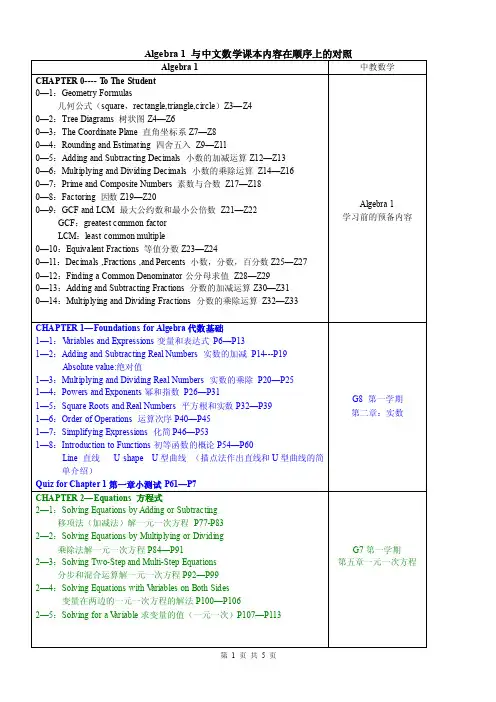
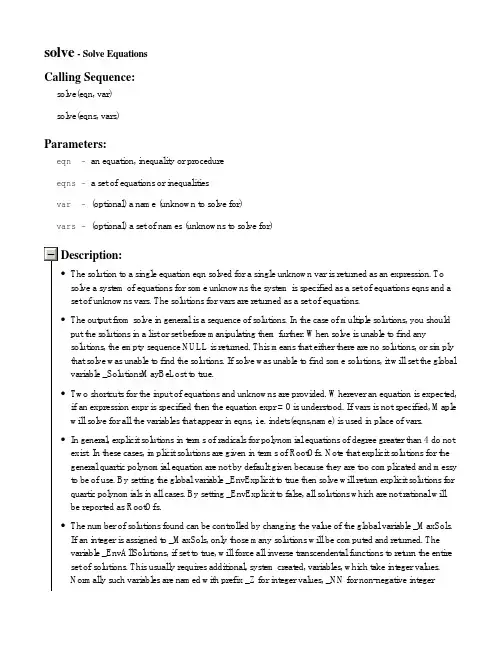
solve - Solve EquationsCalling Sequence:solve(eqn, var)solve(eqns, vars)Parameters:eqn - an equation, inequality or procedureeqns - a set of equations or inequalitiesvar - (optional) a name (unknown to solve for)vars - (optional) a set of names (unknowns to solve for)Description:•The solution to a single equation eqn solved for a single unknown var is returned as an expression. To solve a system of equations for some unknowns the system is specified as a set of equations eqns and a set of unknowns vars. The solutions for vars are returned as a set of equations.•The output from solve in general is a sequence of solutions. In the case of multiple solutions, you should put the solutions in a list or set before manipulating them further. When solve is unable to find anysolutions, the empty sequence NULL is returned. This means that either there are no solutions, or simply that solve was unable to find the solutions. If solve was unable to find some solutions, it will set the global variable _SolutionsMayBeLost to true.•Two shortcuts for the input of equations and unknowns are provided. Wherever an equation is expected, if an expression expr is specified then the equation expr = 0 is understood. If vars is not specified, Maple will solve for all the variables that appear in eqns, i.e. indets(eqns,name) is used in place of vars.•In general, explicit solutions in terms of radicals for polynomial equations of degree greater than 4 do not exist. In these cases, implicit solutions are given in terms of RootOfs. Note that explicit solutions for the general quartic polynomial equation are not by default given because they are too complicated and messy to be of use. By setting the global variable _EnvExplicit to true then solve will return explicit solutions for quartic polynomials in all cases. By setting _EnvExplicit to false, all solutions which are not rational will be reported as RootOfs.•The number of solutions found can be controlled by changing the value of the global variable _MaxSols.If an integer is assigned to _MaxSols, only those many solutions will be computed and returned. Thevariable _EnvAllSolutions, if set to true, will force all inverse transcendental functions to return the entire set of solutions. This usually requires additional, system created, variables, which take integer values.Normally such variables are named with prefix _Z for integer values, _NN for non-negative integervalues and _B for binary values (0 and 1).•A single quadratic equation with constant coefficients in one variable is solved directly by substitution into the quadratic formula. However, if _EnvTryHard is set to true, Maple will try to express solutions in the common radical basis. This may lead to a nicer answer, but can take a long time. •When abs is used in the context of solve, solve assumes that the argument to abs is real-valued.•For solving differential equations, use dsolve . For purely floating-point solutions use fsolve . Use isolve to solve for integer solutions, msolve to solve modulo a prime; rsolve for recurrences, and linalg[linsolve] to solve matrix equations. •Further information is available for the subtopics solve[subtopic] where subtopic is one offloat function identity ineq linear radical scalar series system•For systems of polynomial equations, the function Groebner[gsolve] which uses a Grobner-basis approach may be useful.Examples:> solve( f=m*a, a );f m> solve( {f=m*a}, {a} );{}=a f m > f := proc(x) x-cos(x) end proc:solve( f(x),x);()RootOf − _Z ()cos _Z > eq := x^4-5*x^2+6*x=2;:= eq = − + x 45x 26x 2> solve(eq,x);,,,111−1> sols := [solve(eq,x)];:= sols [,,,111−1> sols[1];1> evalf(sols);[],,,1.1..732050808-2.732050808> sols := {solve(eq,x)};:= sols {},1−11> sols[1];1> subs( x=sols[1], eq );= 22> solve(x^4+x+1,x);()RootOf , + + _Z 4_Z 1 = index 1()RootOf , + + _Z 4_Z 1 = index 2,,()RootOf , + + _Z 4_Z 1 = index 3()RootOf , + + _Z 4_Z 1 = index 4,> evalf({%});− .7271360845.9340992895I − -.7271360845.4300142883I ,,{ + -.7271360845.4300142883I + .7271360845.9340992895I ,}Manipulating Solutions: solve for u,v,w> eqns := {u+v+w=1, 3*u+v=3, u-2*v-w=0};:= eqns {},, = + 3u v 3 = − − u 2v w 0 = + + u v w 1> sols := solve( eqns );:= sols {},, = v 35 = w -25 = u 45check solutions> subs( sols, eqns );{},, = 33 = 11 = 00pick off one solution> subs( sols, u );45assign all solutions> assign( sols );u;45Other Examples> solve( cos(x)+y = 9, x );− π()arccos − y 9> solve( x^2+x>5, x );, RealRange ,−∞ Open − − 12RealRange , Open − + 12∞> solve( x^6-2*x^2+2*x, x );0()RootOf , − + _Z 52_Z 2 = index 1()RootOf , − + _Z 52_Z 2 = index 2,,,()RootOf , − + _Z 52_Z 2 = index 3()RootOf , − + _Z 52_Z 2 = index 4,,()RootOf , − + _Z 52_Z 2 = index 5> solve( {x^2*y^2=0, x-y=1} );,,,{}, = y 0 = x 1{}, = y 0 = x 1{}, = x 0 = y -1{}, = x 0 = y -1> solve( {x^2*y^2=0, x-y=1, x<>0} );,{}, = y 0 = x 1{}, = y 0 = x 1> solve( {x^2*y^2-b, x^2-y^2-a}, {x,y} );{}, = y ()RootOf + − _Z 4_Z 2a b = x ()RootOf − − _Z 2()RootOf + − _Z 4_Z 2a b 2a> _EnvAllSolutions := true:solve( sin(x)=cos(x)-1, x );,−+ 12π2π_Z12π_Z2> r := solve(cos(x),x);:= r + 12ππ_Z3~> subs(op(indets(r))=3, r); # substitute 3 for _Z3~ in r72πSee Also:RootOf , allvalues , dsolve , fsolve , isolve , msolve , rsolve , assign , invfunc , isolate , match , linalg[linsolve], simplex , Groebner。
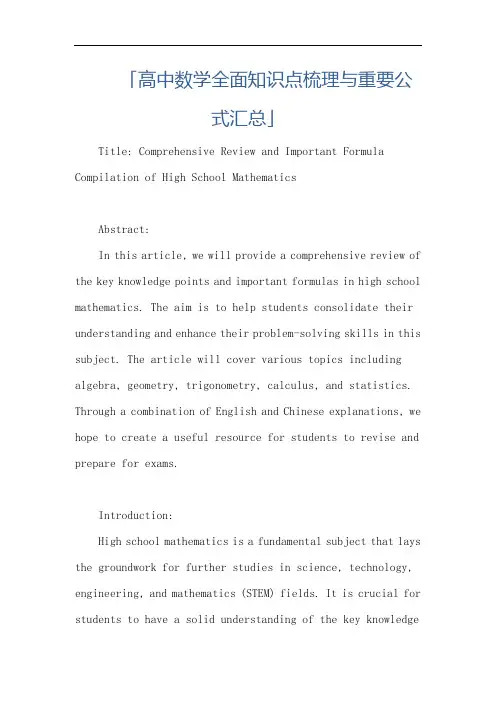
「高中数学全面知识点梳理与重要公式汇总」Title: Comprehensive Review and Important Formula Compilation of High School MathematicsAbstract:In this article, we will provide a comprehensive review of the key knowledge points and important formulas in high school mathematics. The aim is to help students consolidate their understanding and enhance their problem-solving skills in this subject. The article will cover various topics including algebra, geometry, trigonometry, calculus, and statistics. Through a combination of English and Chinese explanations, we hope to create a useful resource for students to revise and prepare for exams.Introduction:High school mathematics is a fundamental subject that lays the groundwork for further studies in science, technology, engineering, and mathematics (STEM) fields. It is crucial for students to have a solid understanding of the key knowledgepoints and be familiar with the important formulas. This article aims to serve as a comprehensive guide, providing a thorough review of these concepts.I. Algebra:1. Basic operations: Addition, subtraction, multiplication, and division of real numbers.2. Equations and inequalities: Solving linear equations and inequalities.3. Functions: Understanding the concept of a function, graphing linear and quadratic functions.4. Exponents and logarithms: Laws of exponents, properties of logarithms.5. Polynomials: Factoring, long division, synthetic division.6. Rational expressions: Simplifying, multiplying, dividing rational expressions.7. Systems of equations: Solving systems of linear equations using substitution, elimination, and matrices.二、几何:1. 基本概念: 点、线、面、角度、直线、平行线、垂直线、多2. 三角形: 三角形的分类、三角形的性质、勾股定理、正弦定理、余弦定理等。
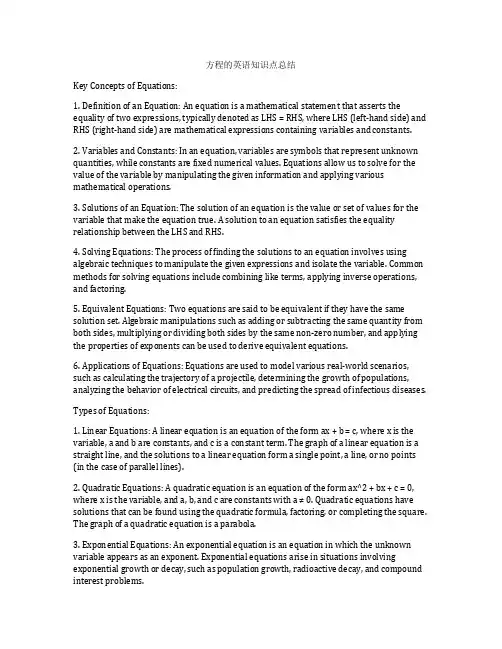
方程的英语知识点总结Key Concepts of Equations:1. Definition of an Equation: An equation is a mathematical statement that asserts the equality of two expressions, typically denoted as LHS = RHS, where LHS (left-hand side) and RHS (right-hand side) are mathematical expressions containing variables and constants.2. Variables and Constants: In an equation, variables are symbols that represent unknown quantities, while constants are fixed numerical values. Equations allow us to solve for the value of the variable by manipulating the given information and applying various mathematical operations.3. Solutions of an Equation: The solution of an equation is the value or set of values for the variable that make the equation true. A solution to an equation satisfies the equality relationship between the LHS and RHS.4. Solving Equations: The process of finding the solutions to an equation involves using algebraic techniques to manipulate the given expressions and isolate the variable. Common methods for solving equations include combining like terms, applying inverse operations, and factoring.5. Equivalent Equations: Two equations are said to be equivalent if they have the same solution set. Algebraic manipulations such as adding or subtracting the same quantity from both sides, multiplying or dividing both sides by the same non-zero number, and applying the properties of exponents can be used to derive equivalent equations.6. Applications of Equations: Equations are used to model various real-world scenarios, such as calculating the trajectory of a projectile, determining the growth of populations, analyzing the behavior of electrical circuits, and predicting the spread of infectious diseases. Types of Equations:1. Linear Equations: A linear equation is an equation of the form ax + b = c, where x is the variable, a and b are constants, and c is a constant term. The graph of a linear equation is a straight line, and the solutions to a linear equation form a single point, a line, or no points (in the case of parallel lines).2. Quadratic Equations: A quadratic equation is an equation of the form ax^2 + bx + c = 0, where x is the variable, and a, b, and c are constants with a ≠ 0. Quadratic equations have solutions that can be found using the quadratic formula, factoring, or completing the square. The graph of a quadratic equation is a parabola.3. Exponential Equations: An exponential equation is an equation in which the unknown variable appears as an exponent. Exponential equations arise in situations involving exponential growth or decay, such as population growth, radioactive decay, and compound interest problems.4. Trigonometric Equations: Trigonometric equations involve trigonometric functions such as sine, cosine, and tangent. These equations often arise in problems related to periodic phenomena, wave functions, and harmonic motion.Properties of Equations:1. Reflexive Property: For any real number a, a = a.2. Symmetric Property: If a = b, then b = a.3. Transitive Property: If a = b and b = c, then a = c.4. Addition Property of Equality: If a = b, then a + c = b + c.5. Subtraction Property of Equality: If a = b, then a - c = b - c.6. Multiplication Property of Equality: If a = b, then ac = bc.7. Division Property of Equality: If a = b and c ≠ 0, then a/c = b/c.8. Multiplicative Property of Zero: For any real number a, a × 0 = 0.9. Multiplicative Property of One: For any real number a, a × 1 = a.10. Distributive Property: For any real numbers a, b, and c, a(b + c) = ab + ac.In conclusion, equations are a vital aspect of mathematics and are used to express and solve a wide range of problems in various fields. Understanding the key concepts, types, and properties of equations is essential for mastering algebra and applying mathematical principles to real-world situations. By studying equations and their properties, one can develop problem-solving skills and analytical thinking, which are invaluable in academic, professional, and everyday life.。
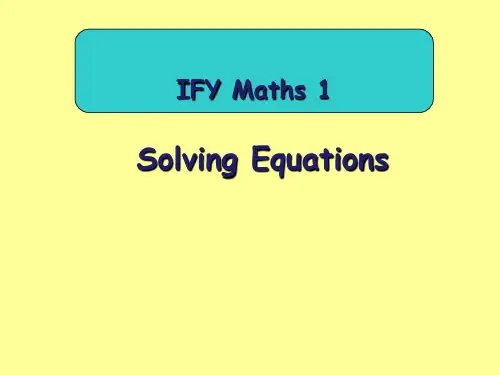
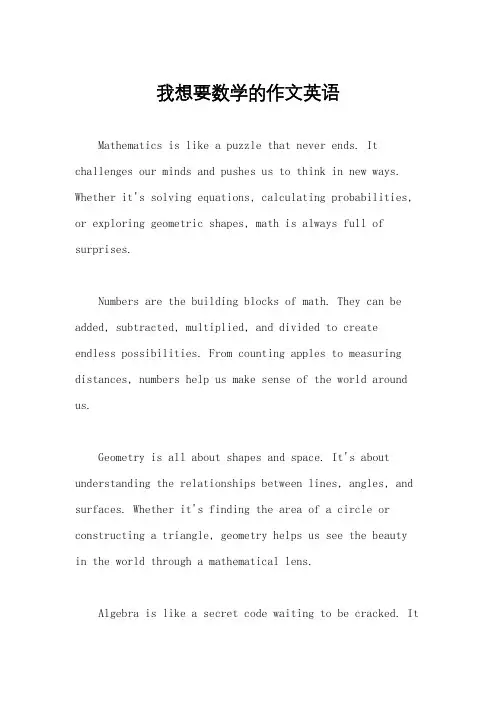
我想要数学的作文英语Mathematics is like a puzzle that never ends. It challenges our minds and pushes us to think in new ways. Whether it's solving equations, calculating probabilities, or exploring geometric shapes, math is always full of surprises.Numbers are the building blocks of math. They can be added, subtracted, multiplied, and divided to create endless possibilities. From counting apples to measuring distances, numbers help us make sense of the world around us.Geometry is all about shapes and space. It's about understanding the relationships between lines, angles, and surfaces. Whether it's finding the area of a circle or constructing a triangle, geometry helps us see the beautyin the world through a mathematical lens.Algebra is like a secret code waiting to be cracked. Itinvolves using symbols and variables to represent unknown quantities. By solving equations and inequalities, we can unlock the mysteries hidden within the numbers and find solutions to complex problems.Statistics is the art of making sense of data. It involves collecting, analyzing, and interpreting information to make informed decisions. From calculating averages to predicting trends, statistics helps us understand the world around us in a quantitative way.Mathematics is not just about numbers and formulas.It's about creativity, problem-solving, and critical thinking. It's about seeing patterns where others see chaos and finding beauty in the complexity of the world. So let's embrace the challenge of math and explore the endless possibilities it has to offer.。
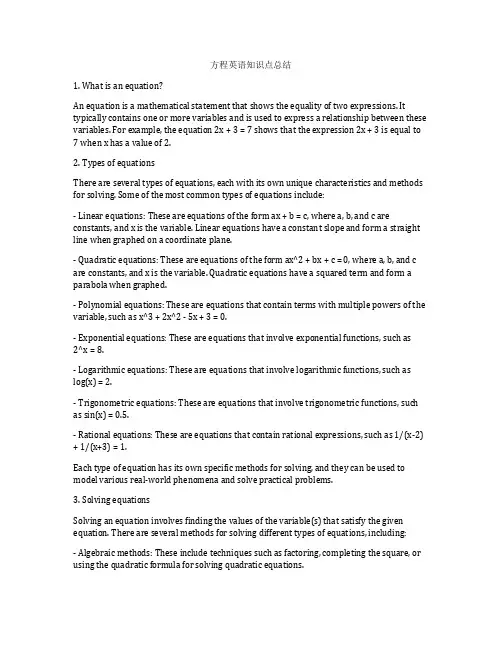
方程英语知识点总结1. What is an equation?An equation is a mathematical statement that shows the equality of two expressions. It typically contains one or more variables and is used to express a relationship between these variables. For example, the equation 2x + 3 = 7 shows that the expression 2x + 3 is equal to 7 when x has a value of 2.2. Types of equationsThere are several types of equations, each with its own unique characteristics and methods for solving. Some of the most common types of equations include:- Linear equations: These are equations of the form ax + b = c, where a, b, and c are constants, and x is the variable. Linear equations have a constant slope and form a straight line when graphed on a coordinate plane.- Quadratic equations: These are equations of the form ax^2 + bx + c = 0, where a, b, and c are constants, and x is the variable. Quadratic equations have a squared term and form a parabola when graphed.- Polynomial equations: These are equations that contain terms with multiple powers of the variable, such as x^3 + 2x^2 - 5x + 3 = 0.- Exponential equations: These are equations that involve exponential functions, such as2^x = 8.- Logarithmic equations: These are equations that involve logarithmic functions, such as log(x) = 2.- Trigonometric equations: These are equations that involve trigonometric functions, such as sin(x) = 0.5.- Rational equations: These are equations that contain rational expressions, such as 1/(x-2) + 1/(x+3) = 1.Each type of equation has its own specific methods for solving, and they can be used to model various real-world phenomena and solve practical problems.3. Solving equationsSolving an equation involves finding the values of the variable(s) that satisfy the given equation. There are several methods for solving different types of equations, including:- Algebraic methods: These include techniques such as factoring, completing the square, or using the quadratic formula for solving quadratic equations.- Graphical methods: These involve graphing the equation on a coordinate plane and determining the points of intersection with the x-axis to find the solutions.- Numerical methods: These involve using iterative algorithms or numerical techniques to approximate the solutions of equations that cannot be solved algebraically.- Trigonometric identities: These are used to simplify and solve trigonometric equations by using the properties of trigonometric functions.- Logarithmic and exponential properties: These are used to simplify and solve equations involving logarithmic and exponential functions by applying the properties of these functions.4. Applications of equationsEquations have numerous applications in various fields, and they are used to model and solve real-world problems in science, engineering, economics, and many other disciplines. Some common applications of equations include:- Physics: Equations such as Newton's second law of motion (F = ma) or the laws of thermodynamics are used to describe and predict the behavior of physical systems.- Engineering: Equations are used to design and analyze structures, machines, and electrical circuits, as well as to solve problems related to fluid mechanics, heat transfer, and materials science.- Economics: Equations are used to model economic relationships and solve optimization problems in areas such as supply and demand, production functions, and cost analysis.- Chemistry: Equations such as the ideal gas law (PV = nRT) or the rate laws for chemical reactions are used to describe the behavior of chemical substances and reactions.- Biology: Equations are used to model population growth, genetics, and ecological systems, as well as to analyze biological data and make predictions about biological processes.These are just a few examples of how equations are used in various fields, and they demonstrate the importance of equations in understanding and solving real-world problems.In conclusion, equations are a fundamental concept in mathematics, and they are used to represent relationships between variables and solve a wide range of problems in different fields. By understanding the different types of equations, methods for solving them, and applications in real-world problems, students can develop a strong foundation in mathematics and gain valuable skills for their future careers.。
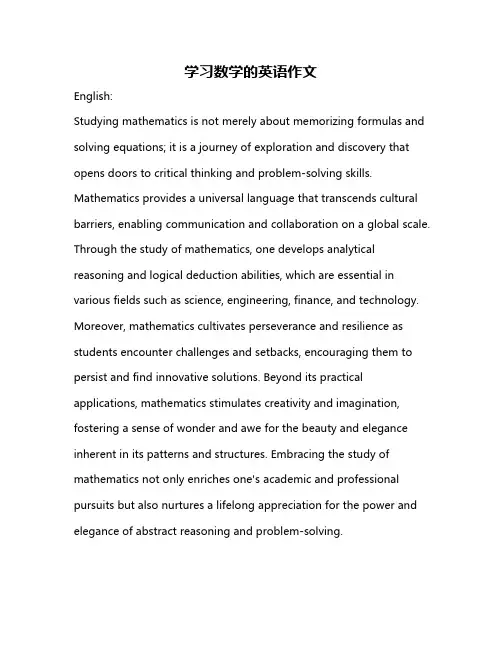
学习数学的英语作文English:Studying mathematics is not merely about memorizing formulas and solving equations; it is a journey of exploration and discovery that opens doors to critical thinking and problem-solving skills. Mathematics provides a universal language that transcends cultural barriers, enabling communication and collaboration on a global scale. Through the study of mathematics, one develops analytical reasoning and logical deduction abilities, which are essential in various fields such as science, engineering, finance, and technology. Moreover, mathematics cultivates perseverance and resilience as students encounter challenges and setbacks, encouraging them to persist and find innovative solutions. Beyond its practical applications, mathematics stimulates creativity and imagination, fostering a sense of wonder and awe for the beauty and elegance inherent in its patterns and structures. Embracing the study of mathematics not only enriches one's academic and professional pursuits but also nurtures a lifelong appreciation for the power and elegance of abstract reasoning and problem-solving.Translated content:学习数学不仅仅是记忆公式和解方程,它是一次探索和发现之旅,打开了批判性思维和解决问题技能的大门。
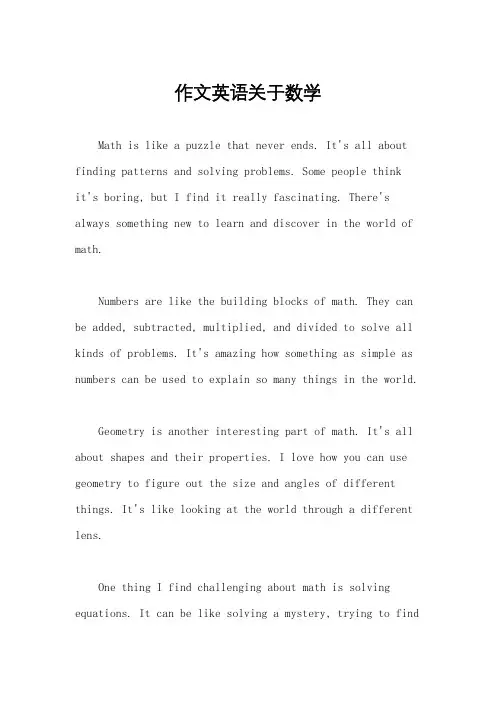
作文英语关于数学Math is like a puzzle that never ends. It's all about finding patterns and solving problems. Some people thinkit's boring, but I find it really fascinating. There's always something new to learn and discover in the world of math.Numbers are like the building blocks of math. They can be added, subtracted, multiplied, and divided to solve all kinds of problems. It's amazing how something as simple as numbers can be used to explain so many things in the world.Geometry is another interesting part of math. It's all about shapes and their properties. I love how you can use geometry to figure out the size and angles of different things. It's like looking at the world through a different lens.One thing I find challenging about math is solving equations. It can be like solving a mystery, trying to findthe value of an unknown variable. But when you finally crack the code and get the right answer, it's such a satisfying feeling.Math is not just about numbers and equations, it's also about logic and reasoning. It teaches you how to think critically and solve problems in a systematic way. These skills are really useful in everyday life, not just in the classroom.I think the best thing about math is that there's always more to learn. No matter how much you know, there's always a new concept or problem to explore. It's like a never-ending journey of discovery.。
写在学校的一天英语作文4-5句英文回答:Today, I had an eventful day at school. I started myday with math class, where we learned about solving equations. Next, I had science class, where we conducted an experiment on the effects of different liquids on plant growth. After lunch, I had English class, where wediscussed the symbolism in a short story. To end the day, I had history class, where we learned about the American Revolution. Throughout the day, I was actively engaged in the lessons and participated in class discussions. Ienjoyed interacting with my classmates and sharing my ideas.I also found the lessons informative and thought-provoking.Overall, I had a productive and enjoyable day at school.I learned a lot of new things, and I feel that I am making progress in my studies. I am looking forward to continuingto learn and grow in the coming weeks and months.中文回答:今天,我在学校过得充实而有意义。
有关解方程的英语Solving Equations: A Crucial Skill in MathematicsEquations are the lifeblood of mathematics, serving as the foundation for understanding and solving a myriad of problems. Whether it's determining the trajectory of a satellite or calculating the speed of an object in motion, the ability to solve equations is indispensable. This essay delves into the importance of solving equations, the various methods employed, and the role they play in the broader context of mathematical problem-solving.The process of solving equations involves finding the value(s) of the variable(s) that make the equation true. This is not merely a mechanical task but often requires a deep understanding of mathematical principles and logical reasoning. Equations can range from simple linear equations with one variable to complex systems of equations with multiple variables.One of the most straightforward methods for solving equations is algebraic manipulation. This involves applying algebraic rules to isolate the variable on one side of the equation. For example, in solving a linear equation like\( ax + b = c \), one might subtract \( b \) from both sides and then divide by \( a \) to solve for \( x \).More complex equations, such as quadratic equations,often require the use of specific formulas or methods. The quadratic formula \( x = \frac{-b \pm \sqrt{b^2 - 4ac}}{2a} \) is a staple in mathematics for finding the roots of any quadratic equation \( ax^2 + bx + c = 0 \).In addition to algebraic methods, graphical methods can also be used to solve equations. By plotting the equation ona graph, one can visually determine the points where thecurve intersects the x-axis, which correspond to thesolutions of the equation.The advent of technology has revolutionized the way we solve equations. Calculators and computer software canquickly and accurately solve even the most complex equations, making it easier for students and professionals alike to find solutions.Solving equations is not just a mathematical exercise; it has real-world applications in various fields. Engineers use equations to design structures, economists to model market behavior, and scientists to understand natural phenomena. The ability to solve equations is a gateway to deeper understanding and innovation across disciplines.In conclusion, solving equations is a fundamental skillin mathematics that is essential for both academic andpractical applications. It requires a combination ofalgebraic techniques, logical thinking, and sometimes the aid of technology. As mathematics continues to evolve, so toowill the methods for solving equations, ensuring that thiscrucial skill remains relevant and powerful in the quest for knowledge and solutions to complex problems.。
标准系数法计算流程The standard coefficient method is a widely used mathematical method for solving equations and systems of equations.标准系数法是一种广泛使用的数学方法,用于解决方程和方程组。
This method involves expressing the coefficients of the variables in the equation as ratios to the coefficient of an arbitrary constant. This allows for the simplification of the equation and makes it easier to solve for the variables.这种方法涉及将方程中的变量系数表达为与任意常数系数的比率。
这使得方程简化,更容易解出变量。
One of the main advantages of the standard coefficient method is that it provides a systematic and organized approach to solving equations. By standardizing the coefficients, the method reduces the amount of manual calculation required and minimizes the potential for error.标准系数法的主要优点之一是它提供了一个系统化和有组织的解方程方法。
通过标准化系数,该方法减少了所需的手动计算量,并最大程度地减少了错误的可能性。
Another benefit of the standard coefficient method is its applicability to a wide range of equations and systems of equations. Whether theequations involve linear terms, quadratic terms, or higher order terms, the standard coefficient method can be used to efficiently and accurately solve them.标准系数法的另一个好处是它适用于各种方程和方程组。
小王子equation插曲英文全文共10篇示例,供读者参考篇1Once upon a time, there was a little boy named Timmy who loved reading books. One day, he came across a book called "The Little Prince" and he was instantly drawn to the charming story of the little prince and his adventures. As Timmy read through the pages, he discovered a special equation that the little prince used to solve problems on his planet.The equation was called the "Little Prince equation" and it went like this: Love + Imagination = Happiness. Timmy was intrigued by this simple yet powerful equation and he decided to try it out in his own life.He started by spreading love to everyone around him, from his family and friends to strangers on the street. He smiled more, gave compliments, and showed kindness wherever he went. And to his surprise, he found that the more love he gave, the more love he received in return.Next, Timmy let his imagination run wild. He dreamt big, explored new ideas, and believed anything was possible. Hepainted colorful pictures, wrote imaginative stories, and created wonderful memories with his loved ones. And as he embraced his creativity, he found that his happiness grew tenfold.In the end, Timmy realized that the Little Prince equation was not just a mathematical formula, but a way of life. By combining love and imagination, he had unlocked the secret to true happiness. And from that day on, he lived his life with an open heart and a creative mind, just like the little prince.So remember, my friends, always keep the Little Prince equation in your heart and watch as love and imagination bring you endless happiness.篇2Once upon a time, there was a little boy named Timmy who loved reading books. One day, he came across a book called "The Little Prince" and he was instantly captivated by the story of the little prince and his adventures. As he read on, he came across a chapter called "The Equation Incident" which piqued his curiosity.In this chapter, the little prince meets a mathematician who is obsessed with finding a mathematical equation that can explain the universe. The mathematician spends all his timescribbling away on a piece of paper, trying to crack the code of the universe. The little prince, however, doesn't understand why the mathematician is so concerned with numbers and equations when there is so much beauty and wonder in the world to explore.As Timmy read on, he started to think about the equation that the mathematician was trying to solve. What if the equation was not just a series of numbers and symbols, but a way to understand the interconnectedness of all things in the universe? What if it was a way to see the beauty and wonder in everything around us?Inspired by the little prince's perspective, Timmy decided to create his own equation, not to solve the mysteries of the universe, but to appreciate the magic and beauty of the world. And so, armed with a piece of paper and a pencil, he began scribbling away, trying to capture the essence of the universe in a simple equation.After hours of scribbling and erasing, Timmy finally came up with his equation:Love + Imagination x Wonder = MagicAnd as he looked at his equation, he realized that the true magic of the universe was not in numbers and calculations, but in the love, imagination, and wonder that we bring to the world. And with a smile on his face, he closed the book and went out to explore the world with a heart full of wonder and magic.篇3Once upon a time, there was a little boy named John who loved reading books. One day, he came across a book called "The Little Prince" and he was immediately drawn into the magical world of the little prince. As he read on, he discovered a special equation that the little prince mentioned in the book:"EQUATION: LEARNING + FRIENDSHIP = HAPPINESS"John was intrigued by this equation and he decided to explore its meaning further. He thought about all the times he had learned something new and how happy it made him feel. He also thought about his friends and how they always brought joy and laughter into his life. He realized that the little prince was right - learning and friendship were indeed the key ingredients to happiness.Inspired by the equation, John decided to try and make new friends at school. He started talking to his classmates more,joining clubs and sports teams, and even helping out with school projects. He found that the more he interacted with others and learned from them, the happier he felt.As time went on, John became known as the friendly and helpful kid in school. He had a big group of friends who supported and encouraged him, and he was always eager to learn new things from them. The equation had truly brought happiness into his life.And so, John learned a valuable lesson from the little prince's equation - that by combining learning and friendship, one could truly unlock the secret to happiness. He treasured the equation and carried it with him wherever he went, knowing that it would always guide him towards a fulfilling and joyful life.篇4Once upon a time, there was a little prince named Little Wang. He lived on a tiny planet called Equation, where everything was perfectly balanced and in harmony.One day, Little Wang was exploring the forests of Equation when he stumbled upon a strange contraption. It was a machine that could solve any mathematical equation with just a press of abutton. Little Wang was fascinated by this machine and decided to try it out.He inputted a simple equation - 2 + 2 = ? - and pressed the button. In an instant, the machine whirred to life and displayed the answer: 4. Little Wang was amazed at how quickly and accurately the machine could solve the equation.Excited, he started inputting more and more complex equations into the machine. He watched in awe as it solved equations like 10 x 5 = ? and (3 + 4) x 6 = ? with ease. Little Wang couldn't believe how powerful the machine was.But as he continued to use the machine, Little Wang started to feel a sense of unease. He realized that he was relying too much on the machine to solve equations for him, instead of using his own brain to figure them out. He also began to miss the joy of solving equations on his own and the sense of accomplishment that came with it.So, Little Wang made a decision. He turned off the machine and put it away. From that day on, he challenged himself to solve equations the old-fashioned way - with pencil, paper, and his own mind. And you know what? Little Wang found that he enjoyed solving equations even more without the help of the machine.And so, the little prince learned an important lesson - sometimes, it's not about finding the quickest or easiest way to solve a problem. It's about the journey of discovery and the satisfaction of using your own abilities to overcome challenges. Little Wang smiled to himself, knowing that he had found the true equation to happiness.篇5Once upon a time, there was a little prince named Little Prince. He lived on a tiny planet with three volcanoes and a beautiful rose. One day, as he was flying through space, he came across a strange planet called Equation.Equation was a very peculiar planet where everything was explained using mathematical equations. Little Prince was fascinated by this and decided to explore the planet further. He met an old mathematician who told him that on Equation, everything could be solved with numbers and symbols.The old mathematician showed Little Prince how to solve equations and Little Prince was amazed at how everything made sense. He learned about addition, subtraction, multiplication, and division, and soon he was able to solve even the most complex equations.As Little Prince continued to explore Equation, he discovered that there was a special equation that could solve any problem in the universe. It was called the Equation of Unity, and it brought balance and harmony to everything it touched.Little Prince knew that he had to share this amazing equation with the rest of the universe. He flew back to his tiny planet and told his rose all about it. The rose was thrilled and together they spread the Equation of Unity to all the planets they visited.And so, thanks to Little Prince and the Equation of Unity, peace and understanding spread throughout the universe. Little Prince was hailed as a hero and his name was forever remembered as the one who brought unity to all.篇6Once upon a time, there was a little boy named Jimmy who loved reading books. One day, he came across a book called "The Little Prince". It was a story about a prince from a faraway planet who traveled to different planets and met various interesting characters.Jimmy was fascinated by the adventures of the Little Prince, especially when he landed on the Equation planet. On this planet, everything was governed by equations and formulas. Eachcharacter had their own equation that determined their behavior and actions.The Little Prince met a quirky character named Equationman who was always solving math problems and equations. Equationman showed the Little Prince how to solve complex equations and understand the world through numbers and symbols.As Jimmy read on, he was intrigued by the concept of equations and decided to try solving some math problems himself. With the help of Equationman, he learned how to use equations to solve real-life problems and even impressed his teacher with his newfound math skills.From that day on, Jimmy became known as the Equationboy and used his knowledge of equations to help others in need. He realized that equations were not just numbers on a page, but powerful tools that could unlock the mysteries of the universe.And so, the adventures of Equationboy continued, as he traveled from planet to planet, using his math skills to solve problems and make the world a better place. And all thanks to the Little Prince and his encounters on the Equation planet.篇7Once upon a time, there was a little boy named Little Prince. He lived on a tiny planet with a single rose and three volcanoes. Little Prince loved to explore the universe and discover new things.One day, as Little Prince was flying through space on his asteroid, he came across a strange planet called Equation. This planet was known for its mysterious equations that controlled everything on the planet. The inhabitants of Equation were all mathematicians who solved problems using numbers and symbols.Curious to learn more about Equation, Little Prince landed on the planet and met a friendly mathematician named Professor Math. Professor Math explained to Little Prince that everything on Equation followed specific equations and formulas, and if one equation was out of balance, it would disrupt the entire planet.Little Prince was fascinated by the concept of equations and decided to learn more about them. Professor Math taught Little Prince different equations such as addition, subtraction, multiplication, and division. Little Prince also learned about advanced equations like algebra, geometry, and calculus.As Little Prince delved deeper into the world of equations, he discovered that they were not just about solving problems butalso about understanding the beauty and order of the universe. He realized that equations were like magic spells that could unlock the secrets of the cosmos.Armed with his newfound knowledge of equations, Little Prince set out on a journey to explore more planets and spread the magic of mathematics. And so, the adventures of Little Prince and his equations continued, as he traveled from planet to planet, solving problems and spreading joy wherever he went.And thus, the Equation planet became a place of wonder and discovery, thanks to the curious little boy who loved to explore the mysteries of the universe. Little Prince had found a new home in the world of equations, where numbers and symbols danced together in perfect harmony.篇8Once upon a time, there was a little prince named Little Prince. He lived on a tiny planet all by himself, with only a beautiful rose for company. One day, as he was wandering through space, he stumbled upon a strange planet called Equation. Curious, he decided to land and explore.As soon as he touched down on Equation, Little Prince was greeted by a group of friendly animals who were experts inmathematics. They were delighted to meet him and wanted to show him their favorite thing in the world - equations.Equations, they explained to Little Prince, were like puzzles that needed to be solved. They showed him simple equations like 2+2=4 and more complex ones like x^2+2x+1=0. Little Prince was fascinated by these mysterious symbols and he eagerly started learning how to solve them.With the help of the animals, Little Prince soon became a master at solving equations. He could solve them in his sleep and even started creating his own equations just for fun. The animals were amazed at how quickly he picked up on the concept and crowned him the Equation Prince.Feeling proud of his new title, Little Prince decided to share his knowledge of equations with his rose back on his tiny planet. He explained to her the beauty of solving equations and how it made him feel smart and accomplished.From that day on, Little Prince became known as the Equation Prince, traveling from planet to planet teaching others the magic of equations. And though he missed his home planet and his beloved rose, he knew that he had found a new passion in the world of mathematics. And so, the Little Prince's equationadventure continued, with each new equation he solved bringing him closer to the stars.篇9Once upon a time, there was a little prince named Little Wang. He had a very special equation that he loved to solve every day. The equation looked like this: Little Prince + Love = Happiness. Little Wang believed that as long as he spread love wherever he went, he would always be happy.One day, Little Wang was flying in his spaceship and landed on a strange planet. There, he met a group of aliens who were very different from him. They spoke a different language and had strange customs. Little Wang was a little scared at first, but he remembered his equation: Little Prince + Love = Happiness.So, he decided to show the aliens some love. He smiled at them and gave them some of the delicious snacks he had brought from his planet. The aliens were surprised at first, but then they started to smile back. Little Wang played games with them and sang songs, and soon they were all laughing and having a great time together.As the day went on, Little Wang realized that even though the aliens were different from him, they were still capable offeeling love and happiness, just like him. He felt grateful for the experience and knew that he had made some new friends on the strange planet.When it was time to leave, the aliens gave Little Wang a special gift to remember them by. It was a shiny star that sparkled brightly in the night sky. Little Wang was overjoyed and knew that his equation had proven true once again: Little Prince + Love = Happiness.And so, Little Wang flew back to his own planet, with a heart full of love and happiness, ready to solve his special equation every day. Because he knew that as long as he spread love, he would always be happy.篇10Once upon a time, there was a little prince named Little Wang. He lived on a tiny planet all by himself. One day, as he was wandering around his planet, he stumbled upon a mysterious equation written in the sand."Whoa, what's this?" Little Wang exclaimed, scratching his head in confusion. The equation looked like this: 2x + 4 = 10. Little Wang had never seen an equation before, but he was determined to solve it.He sat down with a pencil and paper, furrowing his brow as he tried to figure out the answer. "Let's see, if I subtract 4 from both sides, I get 2x = 6. Then, if I divide by 2, x = 3!" Little Wang shouted triumphantly, jumping up and down with joy.Feeling proud of himself, Little Wang decided to show his equation to the other creatures on his planet. He explained how he solved it step by step, and they were all amazed by his cleverness.From that day on, Little Wang became known as the "Equation Prince" by all the inhabitants of his planet. He continued to solve equations and learn more about math, becoming wiser and more knowledgeable with each passing day.And so, the little prince's curiosity and determination led him to discover the magical world of mathematics, proving that even the smallest of beings can achieve great things with the power of knowledge and perseverance. The end.。
leetcode 牛顿法解方程英文Leetcode is a popular platform for coding challenges, and one of the problems it offers is solving equations using Newton's method. Newton's method is an iterative numerical method used to find the roots of a function. In the context of Leetcode, it is often used to solve equations that cannot be easily solved algebraically.To understand how Newton's method can be applied to solve equations, let's consider a simple example. Suppose we want to find the root of the equation f(x) = x^2 - 4. We can start by guessing an initial value for x, let's say x0 = 2. Then, we can use the formula x1 = x0 - f(x0)/f'(x0), where f'(x) represents the derivative of f(x). In our example, f'(x) = 2x, so x1 = 2 - (2^2 - 4)/(2*2) = 1.5. We can repeat this process until we converge to a solution.One advantage of Newton's method is its fast convergence. With each iteration, the approximation of the root becomes more accurate. However, it is important tonote that Newton's method may not always converge or may converge to a local minimum instead of the desired root. Therefore, it is crucial to carefully choose the initial guess and ensure that the function is well-behaved.In the context of Leetcode, solving equations using Newton's method often involves coding a function that implements the iterative process described above. This requires knowledge of programming languages and algorithms. It also requires an understanding of the problem at hand and the ability to translate it into code.Implementing Newton's method to solve equations on Leetcode can be a challenging but rewarding experience. It allows you to apply mathematical concepts and algorithms to real-world problems. It also helps develop problem-solving skills and improves your programming abilities.Moreover, solving equations using Newton's method on Leetcode can be a great way to practice and improve your coding skills. It requires logical thinking, attention to detail, and the ability to break down complex problems intosmaller, manageable steps. It also provides an opportunity to learn and explore different programming languages and techniques.In conclusion, Leetcode offers the opportunity to solve equations using Newton's method, which is a powerful numerical method for finding roots of equations. It requires a combination of mathematical understanding, coding skills, and problem-solving abilities. Implementing Newton's method on Leetcode can be a challenging but rewarding experience that helps improve your programming skills and problem-solving capabilities.。
matlab solve 用法Matlab Solve: A Powerful Tool for Solving EquationsMatlab Solve is a versatile function in Matlab that allows users to solve equations numerically. This tool can handle a wide range of mathematical problems, making it a valuable asset for engineers, scientists, and researchers.With Matlab Solve, users can solve both single-variable and multi-variable equations. Whether you have a simple linear equation or a complex system of nonlinear equations, Matlab Solve can provide accurate solutions quickly and efficiently.To use Matlab Solve, you need to be familiar with the basic syntax. The function takes two arguments: the equations to solve and the variables to solve for. For example, if you have a single-variable equation like "x^2 - 5x + 6 = 0," you can use Matlab Solve as follows:```matlabsyms xeq = x^2 - 5*x + 6 == 0;sol = solve(eq, x);```In this case, the "syms x" command declares a symbolic variable x so that Matlab can solve the equation symbolically. The "eq" variable represents the equation we want to solve, and the "sol" variable stores the solution.For a system of equations involving multiple variables, the process is similar. Let's say we have the following system of equations:```2x + 3y = 74x - 5y = 1```To solve this system using Matlab Solve, we can write the following code:```matlabsyms x yeq1 = 2*x + 3*y == 7;eq2 = 4*x - 5*y == 1;sol = solve([eq1, eq2], [x, y]);```In this example, the "solve" function takes two arguments: a vector of equations [eq1, eq2] and a vector of variables [x, y]. The resulting "sol" contains the solutions for the variables x and y.Matlab Solve is not limited to solving linear equations or systems of equations. It can handle nonlinear equations, polynomial equations, and even differential equations. With its built-in algorithms and numerical methods, Matlab Solve can find solutions accurately and efficiently.In conclusion, Matlab Solve is a powerful tool for solving equations in Matlab. It is flexible enough to handle various mathematical problems, from simple to complex. By utilizing Matlab Solve, users can save time and effort in finding numerical solutions to mathematical equations.。